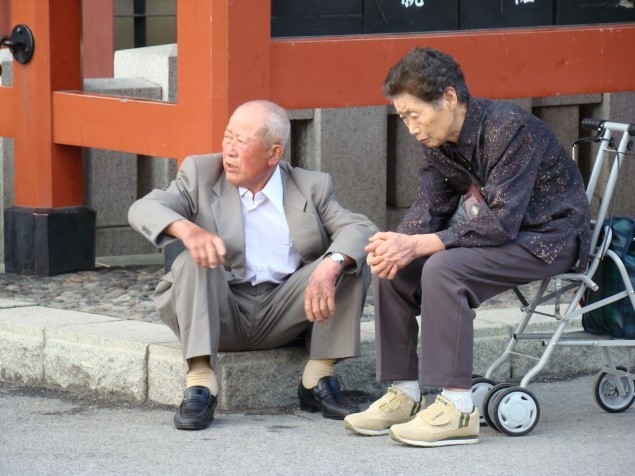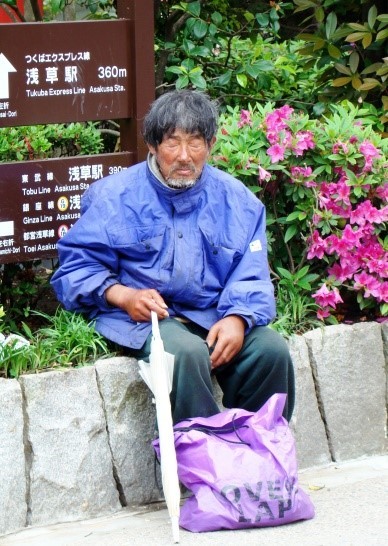· The factors that led to the reduction of the population
The Japanese population in 2009 reached its highest number of population. It reached 127,340,884 million; since thenstenumber decreasing. After only ten years, 2019 already presents a fall population of approximately 2 millions of people. This causes a great impact on the economy and society as a whole, due to population reduction economically active and the consequent reduction of labor, and the increase in elderly population.
Former Minister of Health, Katsunobu Kato, announced that in 2017 only 946,060 children were born, or less registered number since 1899. In contrast, 1.340.433 Japanese passed away. The office of Japan statistics estimates that the population will decline to 100 millions, in 2050, and for just 85 millions, in 2100, that is, a reduction population of 40 millions of the present day.

Numerous factors result in this population decline. In between they, the best known is the well-known media narrative about the “syndrome of celibacy”(em japonês “sekkusu shinai shokogun”). Second Is it over there, young people are not interested in sex. One study carried out by the “National Institute for Research on Population and Social Security”, held in June 2015, pointed out that of the young people in the age between 18 e 30 years, 42% of men and 44% of women are virgins. Approximately one-third of Japanese are entering the house of 30 years without any sexual experience.
Among the various reasons, they consider scary interactions with the opposite sex and find it simpler to consume pornography, turn to sex robots and even the realities virtual, that are easily accessible. Relationships have also declined sex within marriages: in 2017 a survey showed that 47,2% From married had not had sex for a month. The rise of prostitution and its ease of access are other factors that contributed to the decline demographic, since it is no longer necessary to create affective relationships to satisfy sexual desires.

Photo: Fausto Godoy
According to Anne Allison, professor of culture and anthropology at Duke University, although the aforementioned factors are relevant, the main reason that birth rates in Japan are low is economic insecurity. In a country where culturally expect the man to be the provider of the home, supporting the family financially and ensuring the best living conditions, the lack of jobs stable is creating a class of men who do not marry and have no children. for not feeling able to support them. already the women, in the culture japanese, have a more familiar and delicate role, dedicated to taking care of offspring, so much so that it is very common that after the first child, women quit their jobs to take care of the home.
this surprises, because, Japan is a country where the rate of unemployment is just 2,4%. In the post-war years Japan had a tradition of stable jobs, where men started their careers in a company had guaranteed good benefits, salary increases, and there was the understanding that through hard work they would be able to maintain their employment until retirement. However, with globalization this scenario is modified, with the introduction of the principle of recognition of merit within the company. Entrepreneur Carlos Ghosn, responsible for the recovery of Nissan, in 1999, and CEO of the Renault-Nissan alliance, in 2005, was the introducer of this formula, which modified several concepts previously considered unshakable.

Photo: Fausto Godoy
According to Temple University research concerning the types of jobs and number of employees in Japan, near 40% of those jobs are “irregular”, which means that these workers do not occupy stable roles, they receive low wages and do not have benefits; however, are counted as employees in the statistics from the government. Only 20% of these “irregular” workers can better job openings at some point in their careers. O number of stable workers decreased in 3,8 millions, while the number of “irregulars” increased by 7,6 millions. these unemployed, due to the deep sense of honor that underlies Japanese culture, hide their condition and often roam around city parks, like Tokyo wearing social clothing to “dribble” the censorship of your neighbors, for example. However, receive unemployment insurance – shitsugyou hoken – whose value varies according to working time and salary previously perceived.
unemployed in japan (Photos: Fausto Godoy)
Irregular jobs are often held by women, which also generates implications for the constitution of a family, already that working hours are unpredictable and wages are low. However, the man doesn't having a good job is an even bigger obstacle, Antonio expressed his concern and stated that one of the biggest threats to the climate situation lies in gaps in the emission of greenhouse gases. 70% of women stop working after having their first child, because of the structure Social, Japanese customs and values.
Even men with desirable jobs are not being able to start a family, since to keep their places they need work long hours and don't have time to socialize with women or perform any activity other than work.
Population decline will make the job market lose a lot of manpower in the future. However, this phenomenon is opening space for the development of an area already known in Japan: The robotics.
· Robotics
Robots have always been viewed in a positive light in Japan. Some Western studies attribute this phenomenon to religion. Shinto, for which objects have spirit; this makes the Japanese live in harmony with the idea of robots, since for them it is easier to accept them as beings and treat them with respect. influences cultural also generated consequences in the acceptance of this technology, as the theater, the anime and manga, who introduced robot culture to everyday life of the population.
In 1924 there were even plays on the theme. The most popular of these was Jinzo Ningen(artificial human), by Czech screenwriter Karel Capek– R.U.R. Manga also had a very strong impact on robotics., because in them robots are often represented as friends; it was this way that many generations of Japanese, after 1950, developed concepts positives related to robots, taking root, so a friendly relationship between robots and humans in Japan. Examples of success are famous manga Astro Boy and Mazinger Z,
The interest of the Japanese in robotics is old one. Edo period date, between 1603 a 1868, com as Karakuri Nyngyo, which are considered the first Japanese robots. were basically dolls with ropes and gears that moved tea trays, pretended write kanji and some even walked. Nonetheless, O first humanoid robot was the famous Gakutensoku, created in 1928, who was able to blink his eyes and move his pen and your scepter. With regard to artificial intelligence, Wabot 1 was the first; he was raised in 1973, in Tokyo. O Wabot 1 had a system of vision and communication. at the end of the years 90 the first robot was created pet, which initiated the therapeutic use of robots.
Many robotics companies have focused on the side utility of robots to serve as manpower. In consequence, since decade of 70 the country is at the forefront of industrial robotics. At that time the Robots were used in automobile and electronic equipment factories, “Monozukuri”, with the aim of freeing humans from the most stringent. The use of robots became widespread and they began to perform physically hazardous work, like shipping and assembly of heavy parts. No year of 2005 Japan had more than 370.000 robots as labor in their factories.
With the objective of replacing the manpower each day more aged from japan, the number of service robots has grown nowadays: they are the called “social robots”. They are similar in appearance to humans and perform numerous functions, including welcoming people to hotels and hospitals. already in the residences, domestic robots are the most common, like lawn mowers and vacuum cleaners. The acceptance of robotics and its integration into the daily lives of the inhabitants led to the creation of a new form of society, more agile and functional.
· Society 5.0
In 2017 the prime minister of Japan, Shinzo Abe, presentou no “Centrum der Büro und Informationstechnik/” CeBit, O world's most celebrated forum for technology and information technology and Communication, the new concept of japanese society, the society 5.0; Is it over there consists of integrating technology into everyday tasks. this title was due to the fact that this would be the fifth stage of societies: the first was hunting and gathering; the second the agrarian stage, passing, later, to the industrial society – third period – followed by the fourth stage, The information society, for, Finally, a “smart”, which is connected and integrated.

Japan pioneered this new form of society, because it has the structure and social mechanisms to sustain it: always had interest in robotics. And resists accepting immigrants to replace the population decrease. Its civilizational structure aggregates society and remove the “foreigner”: is the “island syndrome”, that unites the population. This new society model would work as follows: the biggest number of information would be loaded into a large database. It is would privilege four major areas: health, mobility, infrastructure and financial technology (fintech).
in the sphere of health, the main problem faced by system are the burdens resulting from the accelerated aging process of the population, of the high costs of medical insurance and the expenses with the seniors. The solution sought through the connected system will be the sharing of medical information and care in remote locations, increasing the patient's independence, that can be taken care of at your home, reducing frequent hospital visits and medical expenses.
In terms of mobility and transport networks, O The phenomenon of “depopulation” in Japan gives rise to an even more serious problem. acute in rural areas, since many people prefer to inhabit the urban areas in search of better jobs. Many inhabitants do not have access to means of transport, makes it difficult to go shopping or even even to hospitals. This lack of accessibility the trade. In contrast, e-commerce has been benefiting and expanding, because orders placed online will be sent using drones. For solve, otherwise these mobility problems, vehicles autonomous buses and taxis will be used for transport, providing the improvement of logistical planning and a more agile and efficient locomotion, what can be monitored by remote control.
In the area of infrastructure, the sensors, the intelligence artificial and robots will be massively employed in this integrated society. THE technology will be used to monitor and inspect the construction of bridges, tunnels, roads and dams, for example, since the conditions weather in Japan are extreme. Similarly, through this control, Disasters can be avoided, increasing security and productivity.
By last, mention should be made of the Fintech sector, term used to symbolize the union of two words, financial and technological. In Japan, many transactions are still carried out using paper money., which slows down operations. Society 5.0 intends to implement a Blockchain technology, kind of database in which they are recorded the bitcoin transactions. When using cryptocurrencies, Besides faster, transactions will be more secure and entered into the system International.
The union between the Japanese history of interest in the area of technology and robotics, associated with demographic challenges, is enabling this new form of society – the society 5.0 – in which the problems social are reduced, or even solved thanks The technology. Nonetheless, robots can replace the work of humans, but the goal is not for machines to take the place of citizens japanese: the purpose is that there is an integration between the technology and the people's everyday activities, making them more profitable and pleasant.
References
ABENOMICS. Realizing Society 5.0. Available in: <https://www.japan.go.jp/abenomics/_userdata/abenomics/pdf/society_5.0.pdf>. Access in: 29 mar. 2019.
GRANRATH, Dr. Lorenz. Japan’s Society 5.0: Going Beyond Industry 4.0. Available in: <https://www.japanindustrynews.com/2017/08/japans-society-5-0-going-beyond-industry-4-0/>. Access in: 29 mar. 2019.
FORK, Arthur. Service robots evolve in Japan. Available in: <https://diplomatique.org.br/robos-de-servicos-evoluem-no-japao/>. Access in: 04 Apr. 2019.
IFR. Why Japan leads industrial robot production. Available in: <https://ifr.org/post/why-japan-leads-industrial-robot-production>. Access in: 03 Apr. 2019.
Japan Business Federation. Toward realization of the new economy and society: Reform of the economy and society by the deepening of “Society 5.0”. April 19, 2016. Available in: <http://www.keidanren.or.jp/en/policy/2016/029_outline.pdf>. Access in: 29 mar. 2019.
POPULATIONPYRAMID. Population Pyramids of the World from 1950 to 2100. Available in: <https://www.populationpyramid.net/japan/2017/>. Access in: 29 mar. 2019.
Turkey's President Asks His Citizens to Boycott French Products. Japan has record number of sexless marriages. Available in: <https://oglobo.globo.com/sociedade/japao-tem-numero-recorde-de-casamentos-sem-sexo-20922252>. Access in: 03 Apr. 2019.
ORTEGA, AndrÉs. Why the Japanese love robots? Available in: <https://brasil.elpais.com/brasil/2016/05/05/ciencia/1462469697_487807.html>. Access in: 04 Apr. 2019.
SEMUELS, Alana. The Mystery of Why Japanese People Are Having So Few Babies: Many point to unromantic 20-somethings and women’s entry into the workforce, but an overlooked factor is the trouble young men have in finding steady, well-paid jobs.. JUL 20, 2017. Available in: <https://www.theatlantic.com/business/archive/2017/07/japan-mystery-low-birth-rate/534291/>. Access in: 29 mar. 2019.
SUN. Charles G.. Available in: <https://www.sunoresearch.com.br/tudo-sobre/carlos-ghosn/>. Access in: 03 Apr. 2019.
TABUCHI, Hiroko. Japanese robots enter daily life. Available in: <https://abcnews.go.com/Technology/story?id=4371176&page=1>. Access in: 03 Apr. 2019.
THEREPORTCOMPANY. How students are being prepared for Society 5.0. Available in: <https://www.globaljapan.world/article/japan-leads-world-in-education-for-society-5-0/>. Access in: 29 mar. 2019.
HITACHI – UTOKYO LABORATORY. Realizing Society 5.0: through “Habitat Innovation”. Available in: <https://socialinnovation.economist.com/pdf/Realizing_Society_5.0_through_Habitat_Innovation_.pdf>. Access in: 29 mar. 2019.
HORNYAK, essential to replace fossil fuels for transport and industries. The face that launched a thousand robots. Available in: <https://www.japantimes.co.jp/life/2008/08/20/digital/the-face-that-launched-a-thousand-robots/#.XKJoNphKiM8>. Access in: 03 Apr. 2019.
U-TOKYO. Japan: the Land of Rising Robotics. Available in: <https://www.u-tokyo.ac.jp/en/whyutokyo/wj_003.html>. Access in: 03 Apr. 2019.
WILFORD, Ggreg. Young Japanese people are not having sex: Nearly a third of Japanese people are entering their 30s without any sexual experience, leaving the country facing a steep population decline. Available in: <https://www.independent.co.uk/news/world/asia/japan-sex-problem-demographic-time-bomb-birth-rates-sex-robots-fertility-crisis-virgins-romance-porn-a7831041.html>. Access in: 03 Apr. 2019.
